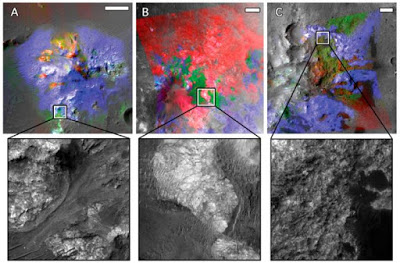
Quenched glasses formed by asteroid impacts can encapsulate and preserve biological material for millions of years on Earth, and can also serve as a substrate for microbial life. These impact glasses are thus an important target to search for signs of ancient life on Mars, but until now they have not been definitively detected on the martian surface.
In this study, Kevin Cannon and John Mustard used orbital remotely sensed data to investigate spectral signatures of geologic units on Mars that were formed during impacts (impactites).
Using spectral mixture modeling, they found that glass is in fact present in these units, mixed with other minerals like olivine and pyroxene. This modeling approach allows for the identification glass signatures that are not otherwise obvious when glass is present in a mixture.
The glass-rich impactites Cannon and Mustard have identified have been preserved on billion-year timescales, old enough to date back to more clement surface conditions on Mars. Their preservation is likely due to the current cold and dry surface environment; therefore, fossilization in glass, as proposed previously, seems to be a promising target to search for possible ancient martian biological activity.
Reference:
Preserved glass-rich impactites on Mars
Kevin M. Cannon and John F. Mustard, Brown University, Providence, Rhode Island, USA. Published online ahead of print on 5 June 2015; DOI: 10.1130/G36953.1
Note : The above story is based on materials provided by Geological Society of America.










